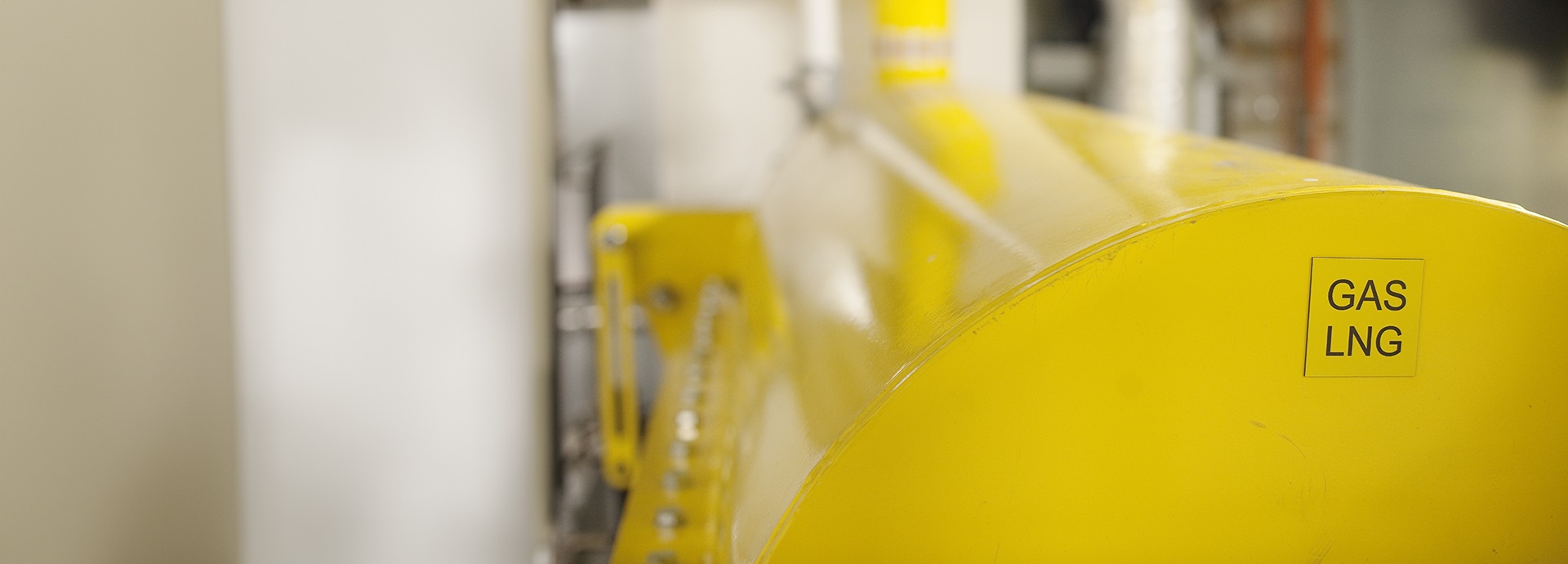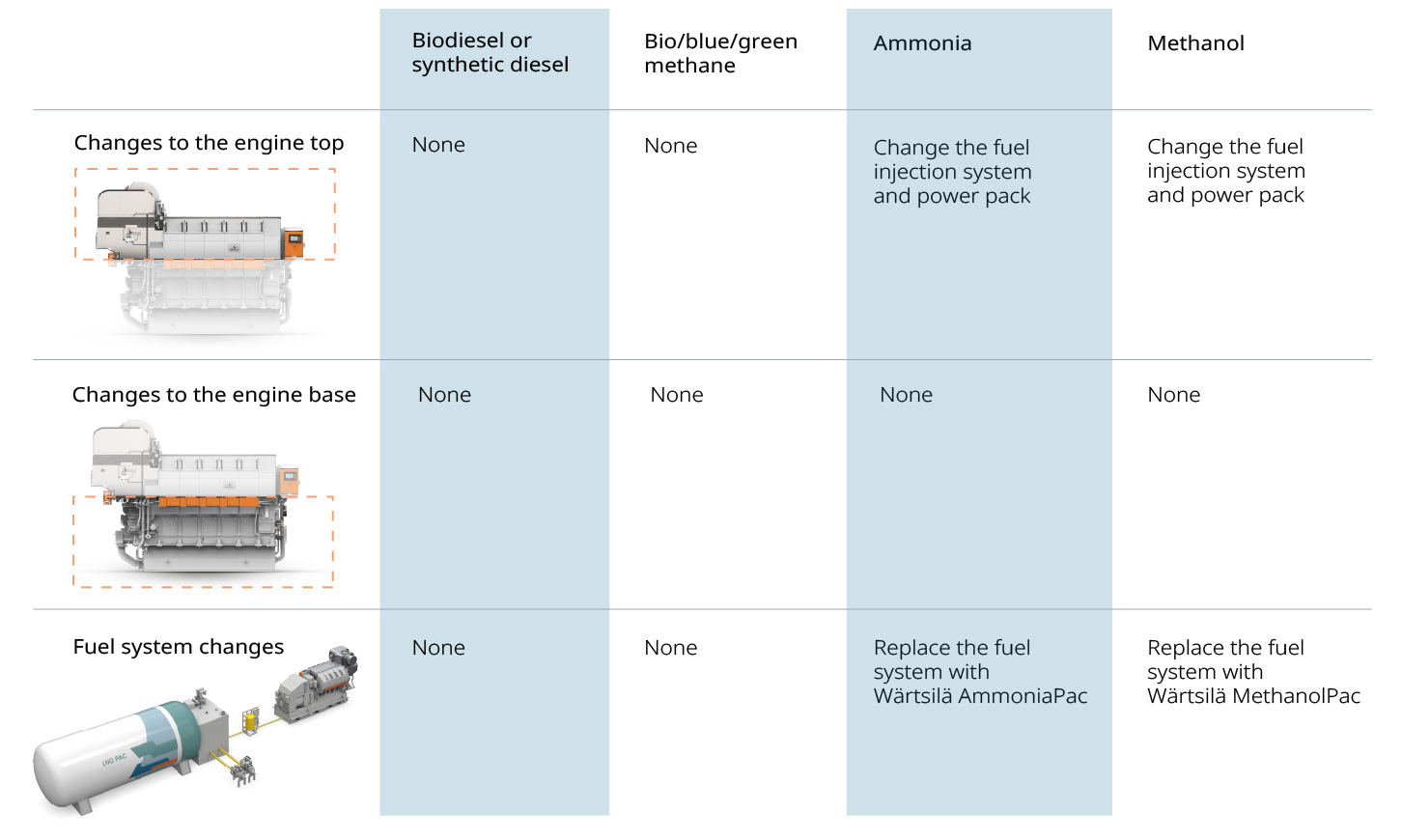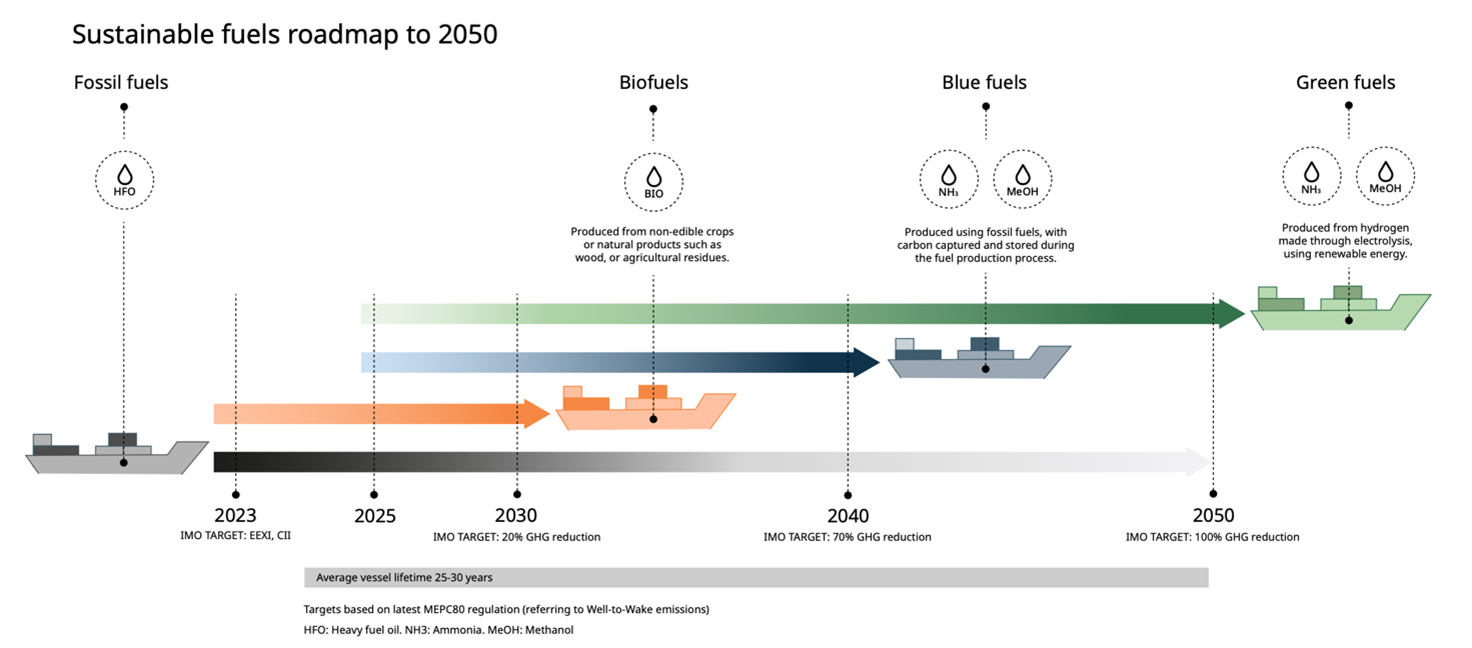

As environmental regulations tighten, vessel owners and operators face growing uncertainty about fuel choices. Could a bridge fuel like LNG or bio-LNG be the smart way to accelerate your journey towards zero-emission green fuels?
To achieve the International Maritime Organization’s target to reach net-zero greenhouse gas emissions by 2050, the shipping industry needs to continuously improve vessel efficiency and reduce emissions. The ultimate goal is to transition to zero-emission green fuels, but making this transition requires a ‘bridge’ between fossil fuels and cleaner alternative fuels. Bridge fuels are a smart way to begin the transition and extend vessel lifetimes while the production of zero-emission alternative fuels is still being scaled up.
What is the difference between fossil LNG and bio-LNG?
Fossil LNG is natural gas that has been extracted from underground reserves onshore (including from shale and other sedimentary rock formations) and offshore. The production process includes separation from oil; removal of water, sulphur and carbon dioxide; and separation of natural gas liquids. The resulting material is then cooled to form LNG – a clear, odourless liquid. LNG is typically 85–95% methane, and it contains small amounts of ethane, propane and other hydrocarbons as well as trace amounts of nitrogen and carbon dioxide.
Bio-LNG – also known as liquefied biomethane, or LBM for short – generates lower greenhouse gas emissions than fossil LNG. Bio-LNG is derived from the liquefaction of biomethane, which can be produced from the degradation of biomass and waste through a chemical or thermal process. Because bio-LNG can be made from feedstock such as agricultural waste, food waste, sewage sludge and manure it is considered a renewable fuel that can further reduce the carbon footprint of ships using LNG fuel systems.
Fossil LNG can help you take the first steps
Using fossil liquified natural gas (LNG) as a bridge fuel can help you to kick start your move away from more polluting fossil fuels like heavy fuel oil (HFO). This is especially true in terms of environmental impact, cost-effectiveness and regulatory compliance.
Here are three benefits of using fossil LNG as fuel:
- Reduced emissions: LNG produces very low levels of sulphur oxides (SOx), and nitrogen oxides (NOx) compared to traditional marine fuels like heavy fuel oil (HFO). This allows ships that use LNG as fuel to comply with current IMO regulations. LNG also reduces particulate matter (PM) emissions, which improves air quality and helps compliance with regional emissions standards. LNG also burns more cleanly than traditional marine fuels and can cut CO2 by up to 20%. This can help to improve a vessel’s CII rating.
- Flexibility: LNG engines are very fuel efficient. Vessels with a dual-fuel engine can switch between LNG and conventional fuel according to fuel availability and price.
- Fuel availability: Global LNG infrastructure is expanding rapidly, with more and more ports around the world providing LNG bunkering stations. This growing infrastructure makes it increasingly feasible for shipping companies to fuel their vessels with LNG along major global shipping routes.
But fossil LNG can only take you so far. To reach the ultimate goal of zero-carbon alternative fuels, the shipping industry needs an even cleaner bridge fuel to close the gap.
Bio-LNG is thought of as a bridge fuel because it is a transitional solution that will reduce carbon emissions while zero-emission fuels are still being developed and their production scaled up. If your ship can run on fossil LNG you will be ready to take the next step to bio-LNG.
4 reasons why bio-LNG is an even more attractive bridge fuel
Here are four reasons why bio-LNG is a good choice for vessels in the short and medium term:
Reason 1: Bio-LNG dramatically lowers carbon emissions
Bio-LNG is nearly carbon-neutral because it recycles carbon that is already part of the natural carbon cycle, unlike fossil fuels which release ancient carbon into the atmosphere. It can reduce emissions by up to 80% compared with traditional marine fuels like HFO.
Reason 2: Bio-LNG contains fewer impurities and less sulphur
Because it is made from organic waste that has already been consumed or processed in some way, bio-LNG typically contains fewer impurities than fossil LNG. This reduces the harmful by-products when the fuel is combusted, such as particulate matter. Due to the production process, bio-LNG also has a lower sulphur content compared to fossil fuels.
Reason 3: Bio-LNG is compatible with existing LNG infrastructure
Ships with LNG-capable engines can use bio-LNG as fuel and refuel using LNG bunkering infrastructure. This compatibility allows shipping companies to switch from conventional LNG to bio-LNG without any retrofits, saving both time and money.
Reason 4: Bio-LNG is a future-proof solution
If your vessel uses bio-LNG as fuel, it will be relatively straightforward to convert your engines to run on carbon-free fuels like green ammonia or green hydrogen once these are available at scale.
What changes are needed to convert a dual-fuel LNG-capable Wärtsilä engine to run on alternative fuels?
Converting an LNG-capable Wärtsilä dual-fuel engine to run on alternative fuels is more straightforward than you might think. This is because Wärtsilä engines have a modular design and are very similar in terms of their structure.
LNG is a great transition fuel also when you need to future-proof your vessel. Upgrading an LNG-operated engine to run on other fuels may be more straightforward than you think.
It is cost-effective to upgrade a Wärtsilä dual-fuel (DF) engine to run on a new fuel because Wärtsilä engines are based on a modular, multi-fuel platform and have structural commonalities.
 Figure 1. The changes needed to convert an LNG-capable Wärtsilä dual-fuel engine to run on alternative fuels.
Figure 1. The changes needed to convert an LNG-capable Wärtsilä dual-fuel engine to run on alternative fuels.
When converting an engine, proper planning and budgeting are a must. Replacing fuel handling and storage systems is significantly more expensive than converting a dual-fuel engine to run on alternative fuels.
Because alternative fuels have lower volumetric efficiency than diesel or LNG, you will need bigger fuel tanks. Bigger tanks need more space, which could mean your ship has to carry less cargo or fewer passengers. Bigger tanks also increase the weight of your vessel, which can reduce its sailing range.
Working with an expert partner like Wärtsilä will help you to optimise weight and space onboard so you gain maximum value from your alternative fuel conversion.
What should you know about using bio-LNG?
While bio-LNG offers many benefits as a bridge fuel, there are some important facts to think about if you are considering making the switch:
- Limited production: The supply of organic waste materials used to produce bio-LNG is finite and varies heavily between geographical regions. However, according to a recent study by the Maritime Energy and Sustainable Development Centre of Excellence (MESD CoE), the potential availability of bio-LNG for the shipping sector is estimated to cover up to 3.1% of the total energy demand for shipping fuels by 2030. This figure will increase to 12.6% by 2050. When considering bio-LNG as a drop-in fuel blended with fossil LNG, its potential energy demand coverage increases significantly.
- Not a zero-emission fuel: While bio-LNG can reduce carbon emissions by up to 80% compared to conventional marine fuels, it’s not a zero-emission fuel. As the shipping industry moves towards net zero in 2050, bio-LNG is a good short and medium-term solution. In the longer term, completely zero-emission fuels like green ammonia, methanol and hydrogen will be needed.
- Methane slip: Methane slip is the term used to describe the unburned methane that escapes from natural gas engines during combustion, and it is a challenge that applied equally to bio-LNG and fossil LNG. The methane that escapes in this way contributes to greenhouse gas emissions. Engine manufacturers like Wärtsilä have been working hard to address this issue for many years and methane slip from engines has been cut dramatically because of this work. Wärtsilä’s NextDF combustion technology reduces NOx emissions by 90%, which cuts methane emissions by over 50%. This adds up to a CO2-equivalent emission reduction of around 10% compared to the current best corresponding engine in Wärtsilä’s portfolio, which already had the industry’s lowest greenhouse gas emissions for a 4-stroke dual-fuel engine.
Handpicked related content: Wärtsilä has been developing gas technologies to reduce methane slip for decades. One of the results of this development work is NextDF. NextDF can be applied to Wärtsilä 31DF and Wärtsilä 25DF engines, both of which already achieve very low emission levels. Hungry for more information about how to reduce methane slip? There are several different methane slip reduction solutions already available!
How can I get started with bio-LNG?
If your ship’s engines can use fossil LNG, then they can use bio-LNG as a drop-in fuel without any changes. Bio-LNG can also be used in existing fossil LNG bunkering stations. A real-world example of a shipping operator that has already done this is Royal Caribbean. In June 2024 their Oasis-class vessel the Utopia of the Seas sailed with bio-LNG from Saint Nazaire, France to Port Canaveral, USA.
The fact that bio-LNG is ready to be used today makes it attractive as a fuel for reducing emissions immediately. You can start with LNG and bio-LNG immediately and be ready for 100% carbon-neutral alternative fuels when they are available at scale. According to a report on future fuels in the maritime industry, the feasible path for future fuels looks like this:

Bio-LNG serves as a good bridge fuel for the shipping industry for three key reasons:
- Bio-LNG allows for immediate and substantial emissions reductions of up to 80% compared to fossil fuels.
- Bio-LNG can use current LNG infrastructure without any changes.
- LNG-capable engines can be easily converted to run on 100% carbon-neutral alternative fuels when it’s time to switch.
What’s the best engine choice for the lifetime of your vessel? This insider’s eGuide has 11 practical tips to help you compare different offerings: Insider’s guide to ship engines.
This article about bio-LNG for maritime applications first appeared as one of Wärtsilä’s Insights stories.
Related solutions
Did you like this? Subscribe to Insights updates!
Once every six weeks, you will get the top picks – the latest and the greatest pieces – from this Insights channel by email.







